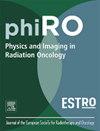Reconstructed dose and geometric coverage for tight margins using intrafraction re-planning on an integrated magnetic resonance imaging and linear accelerator system for prostate cancer patients
IF 3.3
Q2 ONCOLOGY
引用次数: 0
Abstract
Background and purpose
A sub-fractionation workflow enables a substantial reduction in planning target volume (PTV) margin in prostate cancer (PCa) patients by reducing systematic motion during magnetic resonance (MR)-guided radiotherapy. This study assessed geometric and reconstructed dose outcomes in patients treated with a tight-margin sub-fractionation workflow on a combined linear accelerator with a 1.5 T MRI scanner (MR-Linac).
Materials and methods
We evaluated the sub-fractionation workflow with tight margins (2–3 mm) on 128 PCa patients who completed treatment with 5 × 7.25 Gy (36.25 Gy total dose). A traffic light protocol was applied based on residual motions to detect patients with unexpectedly large motions. When ’red’ traffic light criteria were met, plans with larger margins (5 mm isotropic) were adopted for subsequent fractions. Intra- and inter-fraction dose accumulation was performed via an in-house developed deformable image registration algorithm.
Results
A total of 89 % (114/128) of patients completed treatment with the initial tight margins. The mean 3D intrafraction shifts were 1.0 mm (SD: 0.6 mm) in the group with the tight margins and 1.9 mm (SD: 1.5 mm) in the patient group who switched to large margins. The median accumulated D99% was 34.9 Gy (interquartile range: 34.0–35.3 Gy) for patients with prostate shifts who switched to larger margins. In 57 % (8/14) of these patients, the accumulated D99% was above the threshold of 34.4 Gy.
Conclusions
Tight margins of 2–3 mm can be safely applied for at least 95 % (122/128) of the PCa patients undergoing a sub-fractionation workflow on a 1.5 T MR-linac.
在综合磁共振成像和线性加速器系统上重建剂量和几何覆盖对前列腺癌患者的狭窄边缘
背景和目的通过减少磁共振(MR)引导放射治疗期间的系统运动,亚分级工作流程可以大幅减少前列腺癌(PCa)患者的计划靶体积(PTV)边界。本研究评估了在联合线性加速器和1.5 T MRI扫描仪(MR-Linac)上进行紧密亚分割工作流程治疗的患者的几何和重建剂量结果。材料和方法我们评估了128例完成5 × 7.25 Gy (36.25 Gy总剂量)治疗的PCa患者的窄间隙(2-3 mm)亚分步工作流程。采用基于残差运动的红绿灯方案检测运动异常大的患者。当满足“红色”交通灯标准时,后续分数采用更大边缘(5毫米各向同性)的平面图。通过内部开发的可变形图像配准算法进行分数内和分数间剂量累积。结果89%(114/128)的患者完成了初始紧缘治疗。边缘较紧组的平均三维内移为1.0 mm (SD: 0.6 mm),边缘较大组的平均三维内移为1.9 mm (SD: 1.5 mm)。前列腺移位患者的中位累积D99%为34.9 Gy(四分位数范围:34.0-35.3 Gy)。57%(8/14)患者的累积D99%高于34.4 Gy的阈值。结论:至少95%(122/128)的PCa患者在1.5 T MR-linac上进行亚分级工作流程时,可以安全地应用2-3 mm的边缘。
本文章由计算机程序翻译,如有差异,请以英文原文为准。
求助全文
约1分钟内获得全文
求助全文
来源期刊

Physics and Imaging in Radiation Oncology
Physics and Astronomy-Radiation
CiteScore
5.30
自引率
18.90%
发文量
93
审稿时长
6 weeks
 求助内容:
求助内容: 应助结果提醒方式:
应助结果提醒方式:


